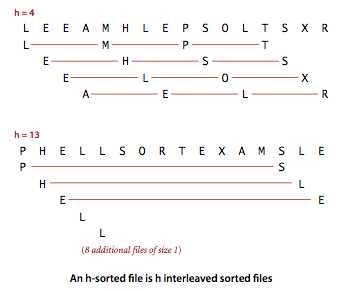标签:ted 数组 false static sort system ++ alt []
public class TestMain { public static void main(String[] args) { Integer[] a = new Integer[5000]; for (int i = 0; i < a.length; i++) { int temp = (int)(StdRandom.random()*10000); a[i] = temp; } Integer[] b = new Integer[5000]; for (int i = 0; i < b.length; i++) { b[i] = a[i]; } //生成两个相同的随机数组 Stopwatch timer2 = new Stopwatch(); ToSort.insertsort(b); System.out.println(timer2.elapsedTime()); //比较两种排序运行的时间 Stopwatch timer = new Stopwatch(); ToSort.shellsort(a); System.out.println(timer.elapsedTime()); } } class ToSort{ /* * 插入排序 * 时间复杂度O(N^2) N为数组长度 */ public static void insertSort(Comparable[] a) { for (int i = 1; i < a.length; i++) { //从 1项开始,递增项数,将前 i 项进行排序 //int temp = (int) a[i]; int j; for ( j = i; j > 0 && less(a[j] /*如果改为右移这里则改为 temp*/, a[j-1]); j--) { //前 i-1 项为已排好序的数组,将第 i 项与 i-1 项比较,比前面的小则交换两项,然后继续比较 i-1 和 i-2 //例子:1,4,8,3 排序后将 3 插入到了 4 前面 1,3,4,8 exch(a, j, j-1); //这里将交换改为右移可以提高速度 a[j] = a[j-1]; } //a[j] = temp; } } /* * 希尔排序 */ public static void shellSort(Comparable[] a) { int T = a.length; int h = 1; while(h<T/3) h = h*3 + 1; //使用 1, 4, 13, 40, 121这个希尔序列 while (h >= 1) { //当 h 为 1 时,其实就是插入排序,但前面的工作可以使整个过程变快 for (int i = h; i < T; i++) { //按当前间隔 h 进行比较,从第一个数开始每隔 h 取一个数,组成数组,进行排序。 for (int j = i; j >= h && less(a[j], a[j-h]) ; j -= h) { exch(a, j, j-h); } } h = h/3; } } /* * 判断是否v < w */ private static boolean less(Comparable v, Comparable w) { return v.compareTo(w) < 0; //+1则false,-1则true } /* * 交换a[i]与a[j]的值 */ private static void exch(Comparable[] a, int i, int j) { Comparable t = a[i]; a[i] = a[j]; a[j] = t; } /* * 打印出数组 */ public static void show(Comparable[] a) { for (Comparable comparable : a) { System.out.print(comparable+" "); } System.out.println(); } /* * 判断数组是否有序 */ public static boolean isSorted(Comparable[] a) { for (int i = 1; i < a.length; i++) { if (less(a[i], a[i-1])) return false; } return true; } }
希尔排序示意图

标签:ted 数组 false static sort system ++ alt []
原文地址:http://www.cnblogs.com/zhangqi66/p/7244442.html